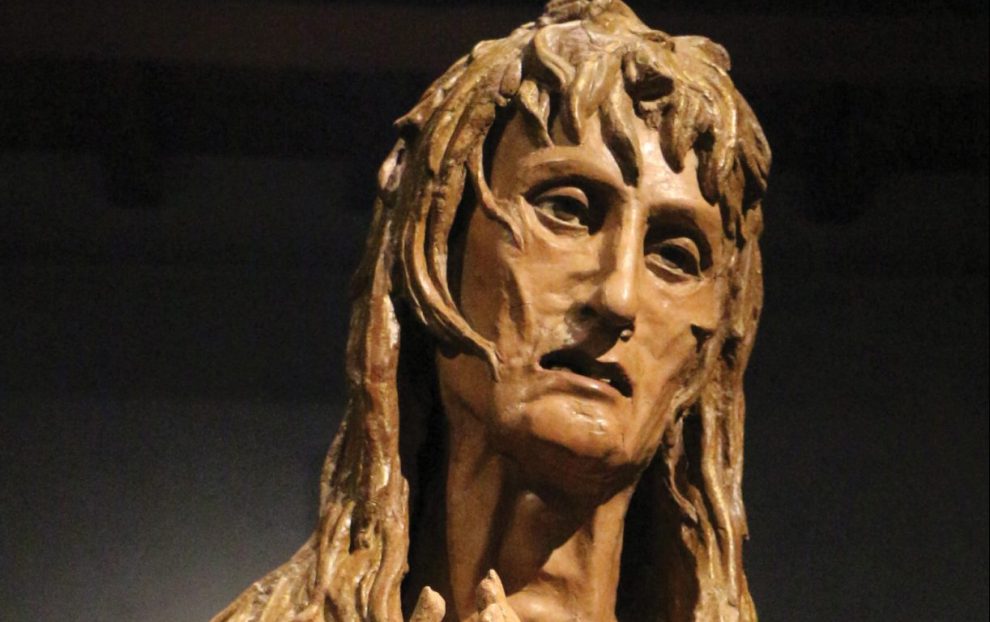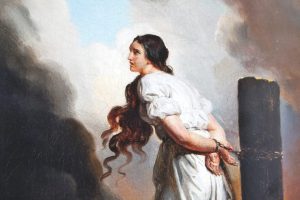If you attended parochial school some decades ago, you probably had a few Marys in your class. They would include, of course, Marias, Marians, Mary Annes, Mary Alices, and Mary Janes. Having Mary as a middle or confirmation name was equally common. In Latino/a communities, boys as well as girls bear the name with pride. The Mother of God is so revered in Catholic tradition that it was long considered an honor to be named for her.
Very few children of earlier generations were deliberately named for that other significant Mary of the gospels, Mary Magdalene. Perhaps this is because she was often confused with the unnamed woman who wiped the feet of Jesus with her hair. Marys of the New Testament can get in such a tangle: Martha of Bethany’s sister and Mary the wife of Clopas add to the scramble. Evidently Mary was a popular name in the time of Jesus, too.
Statues of the Blessed Virgin Mary are essential components of any Catholic church. The Madonna appears in many variations: the mother presenting her divine child, the female anchor of the holy family, the sorrowful mother embracing her dead son, as well as the chaste woman who seems to gather the stillness around her in splendid aloneness. Our Lady of Guadalupe, patroness of the Americas, is omnipresent in our parish spaces, as are representations of Mary’s apparition at Lourdes, Fatima, Carmel, or ethnic depictions of every race and culture.
By contrast, statues of Mary Magdalene are quite rare. Italian sculptor Donatello did one in the 15th century. It portrays Mary in her mistaken role as a penitent figure dressed in nothing but her shaggy body-length hair. Many artists painted portraits of Mary Magdalene in a cave or wilderness setting doing penance for her sins, often wearing a coarse hair garment with a skull in view to remind viewers that life is brief and the opportunity for repentance short. Mary’s head is traditionally uncovered and not graced with a halo, as is expected of saintly figures.
While Jesus may have redeemed her from her demons, artists were less eager to do so. Baroque artist Caravaggio famously painted Mary Magdalene in ecstasy, hair flowing freely and robe slipping off her shoulders. And Caravaggio wasn’t the only one to present Mary as an object of thinly veiled desire. She’s the rare holy woman who gave male artists what they wanted: the chance to paint an odalisque disguised as a saint.
Crucifixion scenes often include Mary Magdalene. She did, after all, demonstrate a fearless fidelity to Jesus in his final hours. Yet she’s generally the only person in the frame missing a halo, not to mention the only woman unveiled. Her old identification as a marked woman who used her shamelessly loose hair to wipe Jesus’ feet is something artists could not resist.
Orthodox artists are kinder. In classic icons, they portray Mary Magdalene knowingly displaying an Easter egg, the symbol of hidden new life. Or holding an urn of oil and perhaps a candle, since her dangerous assignment that dark morning was to anoint the Lord’s body. Incidentally the Orthodox always grant Mary Magdalene an unambiguous halo. This wiser and more purposeful Mary is true to Luke’s presentation of her as one of several women who financed Jesus’ ministry as they traveled with him as his disciples. It implies they were taught along with the rest—and perhaps understood the perilous road to Jerusalem a little more keenly than his male followers.
These days, modern artists attempt to reincarnate this other vital Mary. Some modern images are sentimental: She clutches a cross to her breast with tears starting from her eyes. Gnostic-identified artists carve her in a squat Venus-of-Willendorf-like posture, modestly clothed and veiled but with an open pot in her lap, suggesting healing authority or even fertility.
Only in our generation has the church finally been prepared to reclaim this ancient and powerful woman for who she truly is: the apostle to the apostles, as Thomas Aquinas rightly declared her in the 13th century. Her memorial day, July 22, was upgraded to a feast of the church in 2016 by a personal request of Pope Francis. This is significant. The only commemoration on the church calendar higher than a feast is a solemnity, reserved for celebrations of Jesus, his mother, Peter, Paul, and John the Baptist.
Does this mean Mary M will be getting her well-deserved halo at last? Or that we’ll be seeing statues of her on church grounds? What’s perhaps just as exciting is that in 2009 archaeologists began uncovering the ruins of the city of Magdala on the Galilee, once a thriving town for fishermen and merchants. It was here, not far from Nazareth and Capernaum, where Jesus healed a severely afflicted woman who would make her town famous. Mary was dispossessed of seven demons on that day, Luke tells us. Her troubles were so comprehensive that they could have left her both physically and mentally ill. At any rate, Mary had been so bound by sickness that her release propelled her to abandon the life she knew in favor of full-time allegiance to the mission of Jesus. If Magdala was known for shopkeepers, and Mary had resources to finance Jesus’ ministry, chances are she’d have been a prosperous shopkeeper before the season of her affliction.
Next to the archaeological site in Magdala is a recently erected shrine that takes its place among the multitude of impressive shrines in the Holy Land. Called Duc in Altum, the name comes from Jesus’ command to his disciples to “launch into the deep” if they expect to catch fish. The main entrance hall is defined as the Women’s Atrium, with eight pillars paying homage to the holy women who followed Jesus. Mary Magdalene’s name is inscribed on one, and her fellow financiers of the gospel mission, Susanna and Joanna (Luke 8:3), grace another. Martha and Mary, sisters from Bethany (Luke 10:38), share a pillar. Salome, mother of Zebedee’s sons (Matt. 20:20), Simon Peter’s mother-in-law (Matt. 8:15), and Clopas’ wife (John 19:25) each have their own.
The seventh pillar remembers the “many other women” (Mark 15:41) who traveled with Jesus since his Galilee days. All of these women surely “launched into the deep” to travel and study with Jesus in an era that didn’t actually encourage women to keep company with a man who wasn’t their spouse. To these women, of course, a spiritual union more remarkable than marriage bound them to their teacher. While many of the male disciples put down their nets to go on the road with Jesus, these women picked up their purses—and perhaps a few cooking necessities—to do the same.
The eighth pillar in the Women’s Atrium at Magdala is the most moving. It bears no inscription at all. The unmarked pillar represents unnamed women throughout history who follow Jesus. They open their purses or take up knitting needles to assist the poor. They study theology or share their faith with their children. They cook at parish suppers or serve on lay missions. They profess religious vows or dedicate themselves to vital secular professions. Women who visit this shrine leap into the frame when we take a picture of this pillar, reaching out to connect with its smooth surface. We all know this one’s for us.
This article also appears in the April 2023 issue of U.S. Catholic (Vol. 88, No. 4, pages 47-49). Click here to subscribe to the magazine.
Image: Mary Magdalene, Donatello. Via Wikimedia Commons













Add comment